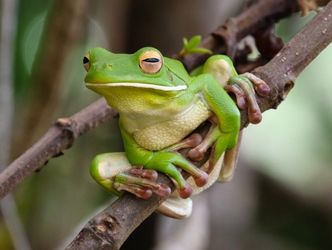Critter Corner – White-lipped tree frog

White-lipped Tree Frog © David White Solar Whisper
#CritterCorner – Named after its distinctive white lips, the White-lipped tree frog (Litoria infrafrenata) is Australia’s largest native frog (up to 14 cm). Their diet is mainly insects and arthropods.
The White-lipped tree frog’s colour can vary – some are pure green, some are a greenish shade of brown, and others aren’t so green at all (more of a pale brown). If you’re lucky, during the breeding season, you may spy some that have a salmon-pink colouration down their arms and legs. Intrigued? Check out Solar Whisper‘s photo gallery.
Regardless of their shade, one thing they all have in common is a white stripe along their lower jaw which continues down the sides of their heads. Even the tadpoles, which are dark brown in colour, have a single cream-coloured stripe on each side of the head, body, and tail.
Breeding season is during spring and summer when the males call out with a distinct (and loud) ‘wark, wark’ that resembles a dog barking (listen here). Once mating is complete, up to 100 brown eggs are laid in clear jelly clumps on the water’s surface in permanent and temporary pools. The entire process of development, from egg to tadpole to frog, takes around eight weeks in total. Fun Fact: The frog also emits a cat-like ‘meow’ sound when distressed.
Found in northeast Queensland and Papua New Guinea, while this amphibian is generally found in low-lying coastal areas, it also lives in closed forests, heathland swamps, dry sclerophyll forests, tea tree swamps, and mangroves. Because the species is able to tolerate heavily modified environments they may also inhabit urban gardens and parks.
The White-lipped tree frog (Litoria infrafrenata) is listed as ‘Least Concern’ on the IUCN Red List.
Information sourced from Queensland Government Department of Environment
Want more good Rainforest news in your life?
Subscribe to our eNews | Follow us on Instagram | Like us on Facebook | Subscribe to our YouTube channel
Help Protect Rainforests Forever
Donate to Protect Rainforests Forever | Become a Rainforest Guardian | Partnership Options

